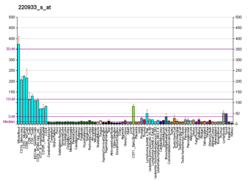ZCCHC6
| TUT7 | |||||||||||||||||||||||||||||||||||||||||||||||||||
|---|---|---|---|---|---|---|---|---|---|---|---|---|---|---|---|---|---|---|---|---|---|---|---|---|---|---|---|---|---|---|---|---|---|---|---|---|---|---|---|---|---|---|---|---|---|---|---|---|---|---|---|
| Identifiers | |||||||||||||||||||||||||||||||||||||||||||||||||||
| Aliases | TUT7, PAPD6, zinc finger CCHC-type containing 6, TENT3B, ZCCHC6, terminal uridylyl transferase 7 | ||||||||||||||||||||||||||||||||||||||||||||||||||
| External IDs | OMIM: 613467 MGI: 2387179 HomoloGene: 51941 GeneCards: TUT7 | ||||||||||||||||||||||||||||||||||||||||||||||||||
| |||||||||||||||||||||||||||||||||||||||||||||||||||
| |||||||||||||||||||||||||||||||||||||||||||||||||||
| |||||||||||||||||||||||||||||||||||||||||||||||||||
| |||||||||||||||||||||||||||||||||||||||||||||||||||
| |||||||||||||||||||||||||||||||||||||||||||||||||||
| Wikidata | |||||||||||||||||||||||||||||||||||||||||||||||||||
| |||||||||||||||||||||||||||||||||||||||||||||||||||
Terminal uridylyltransferase 7 (TUT7), also known as "zinc finger, CCHC domain containing 6", is an enzyme that in humans is encoded by the ZCCHC6 gene located on chromosome 9.[5][6] The ZCCHC6 protein mediates the terminal uridylation of RNA transcripts with short poly-A tails and is involved in mRNA and microRNA degradation
Structure[edit]
The ZCCHC6 gene contains 33 exons with at least six known isoforms due to alternative splicing. The ZCCHC6 gene encodes for a protein that is 171 kDa in molecular weight and is localized to the cytoplasm.
Function[edit]
It catalyzes the following reaction, requiring Mg2+ and Mn2+ as co-factors.
UTP + RNA(n) = diphosphate + RNA(n+1) [7]
Uridylation catalyzed by ZCCHC6 takes place readily on deadenylated mRNAs inside the cells.[8] Purified ZZHC6 selectively recognizes and uridylates RNA molecules possessing short poly(A) tails (less than 25 nucleotides) in vitro. In cells depleted of ZCCHC6, the majority of mRNAs lose the signature oligo(U) tails that are characteristic of ZCCHC6 reactivity, and the half-life of mRNA molecules are accordingly prolonged.[8]
In addition to mRNA degradation, uridylation is also thought to function in pre-microRNA maturation, with some group II pre-microRNA requiring 3' mono-uridylation for Dicer processing.[9] ZCCHC6 is thought to work in redundancy with ZCCHC11 to mediate the biogenesis of the let-7 microRNA through uridylation.[10]
Genetic Inactivation of ZCCHC6 Suppresses Interleukin-6 Expression and Reduces the Severity of Experimental Osteoarthritis in Mice.[11]
References[edit]
- ^ a b c GRCh38: Ensembl release 89: ENSG00000083223 – Ensembl, May 2017
- ^ a b c GRCm38: Ensembl release 89: ENSMUSG00000035248 – Ensembl, May 2017
- ^ "Human PubMed Reference:". National Center for Biotechnology Information, U.S. National Library of Medicine.
- ^ "Mouse PubMed Reference:". National Center for Biotechnology Information, U.S. National Library of Medicine.
- ^ Nagase T, Kikuno R, Hattori A, Kondo Y, Okumura K, Ohara O (December 2000). "Prediction of the coding sequences of unidentified human genes. XIX. The complete sequences of 100 new cDNA clones from brain which code for large proteins in vitro". DNA Research. 7 (6): 347–355. doi:10.1093/dnares/7.6.347. PMID 11214970.
- ^ "Entrez Gene: ZCCHC6 zinc finger, CCHC domain containing 6".
- ^ Rissland OS, Mikulasova A, Norbury CJ (May 2007). "Efficient RNA polyuridylation by noncanonical poly(A) polymerases". Molecular and Cellular Biology. 27 (10): 3612–3624. doi:10.1128/MCB.02209-06. PMC 1899984. PMID 17353264.
- ^ a b Lim J, Ha M, Chang H, Kwon SC, Simanshu DK, Patel DJ, Kim VN (December 2014). "Uridylation by TUT4 and TUT7 marks mRNA for degradation". Cell. 159 (6): 1365–1376. doi:10.1016/j.cell.2014.10.055. PMC 4720960. PMID 25480299.
- ^ Heo I, Ha M, Lim J, Yoon MJ, Park JE, Kwon SC, et al. (October 2012). "Mono-uridylation of pre-microRNA as a key step in the biogenesis of group II let-7 microRNAs". Cell. 151 (3): 521–532. doi:10.1016/j.cell.2012.09.022. PMID 23063654.
- ^ Thornton JE, Chang HM, Piskounova E, Gregory RI (October 2012). "Lin28-mediated control of let-7 microRNA expression by alternative TUTases Zcchc11 (TUT4) and Zcchc6 (TUT7)". RNA. 18 (10): 1875–1885. doi:10.1261/rna.034538.112. PMC 3446710. PMID 22898984.
- ^ Ansari MY, Khan NM, Ahmad N, Green J, Novak K, Haqqi TM (April 2019). "Genetic Inactivation of ZCCHC6 Suppresses Interleukin-6 Expression and Reduces the Severity of Experimental Osteoarthritis in Mice". Arthritis & Rheumatology. 71 (4): 583–593. doi:10.1002/art.40751. PMC 6438766. PMID 30302948.
Further reading[edit]
- Hartley JL, Temple GF, Brasch MA (November 2000). "DNA cloning using in vitro site-specific recombination". Genome Research. 10 (11): 1788–1795. doi:10.1101/gr.143000. PMC 310948. PMID 11076863.
- Wiemann S, Weil B, Wellenreuther R, Gassenhuber J, Glassl S, Ansorge W, et al. (March 2001). "Toward a catalog of human genes and proteins: sequencing and analysis of 500 novel complete protein coding human cDNAs". Genome Research. 11 (3): 422–435. doi:10.1101/gr.GR1547R. PMC 311072. PMID 11230166.
- Wiemann S, Arlt D, Huber W, Wellenreuther R, Schleeger S, Mehrle A, et al. (October 2004). "From ORFeome to biology: a functional genomics pipeline". Genome Research. 14 (10B): 2136–2144. doi:10.1101/gr.2576704. PMC 528930. PMID 15489336.
- Mehrle A, Rosenfelder H, Schupp I, del Val C, Arlt D, Hahne F, et al. (January 2006). "The LIFEdb database in 2006". Nucleic Acids Research. 34 (Database issue): D415–D418. doi:10.1093/nar/gkj139. PMC 1347501. PMID 16381901.


 French
French Deutsch
Deutsch



